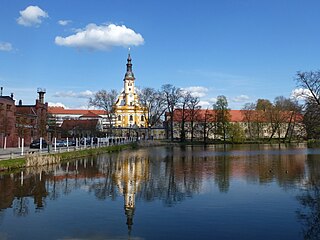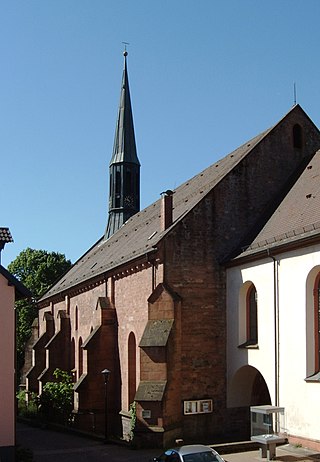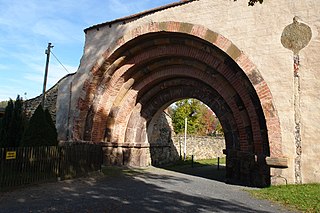History
The abbey was legally founded on 1 May 1165 by charter of Margrave Dietrich of Landsberg und Eilenburg and of the Ostmark of Lusatia, but because of continuing hostilities in the area the community did not make any real progress until 1184, when twelve monks from Volkenroda Abbey began the settlement in earnest. By 1209 building was far enough advanced for it to be possible to bury the Margravine Elisabeth, wife of the Margrave Konrad II, in the abbey church.
Generous endowments enabled the monastery to grow very rapidly thereafter, however. In 1234 it already owned 18 villages and from 1240 it was sufficiently powerful economically to increase its land-holdings by its own purchases, rather than depending on donors. In a deed of 1370 Emperor Charles IV confirmed the monks in possession of 40 villages and five farmyards. The abbey was also the lord of the little town of Kirchhain, to which they had granted the right to hold a market in 1235. In addition, the abbey had premises in the more important towns of Luckau, seat of the territorial prince, and in Lübben (which between about 1301 and 1329 belonged to the abbey), in order to deal more efficiently with the sale of agricultural produce. Like all Cistercian abbeys, Dobrilugk was exempt from episcopal tithes.
The abbey was deeply involved in medieval land development in the west of Lower Lusatia. The monks recruited German settlers who established several villages on abbey lands; most of the serfs however were Sorbs. The abbot of Dobrilugk had a seat and a vote in the Prelates' Curia of the Lower Lusatian Landtag .
At the end of the 14th century began the slow decline of the abbey. The monks no longer undertook cultivation themselves, but relied on the income from rents and taxes. There were simply no longer enough men available to enter the abbey as lay brothers (conversi) to carry out the physical tasks.
In 1431 Dobrilugk was plundered by the Hussites.
Nevertheless, economically the abbey continued to prosper. In a document of 1434 the abbey is shown as the owner of no less than 65 villages.
The end came with the Reformation. Since the 1520s monks had been leaving and turning to the new teachings. Monastic discipline and also the economics of the abbey fell into disorder. In 1533 the abbot absconded with the abbey's portable valuables. In addition, Emperor Ferdinand I demanded high contributions from the Lower Lusatian abbeys to finance the Turkish wars. Finally, in 1541, Johann Friedrich I, Elector of Saxony, occupied Dobrilugk, because of a financial claim he had against the King of Bohemia, in whose territory it was. The monks abandoned the monastery and the community was dissolved.
Although the Roman Catholic Ferdinand I was able to win back the abbey lordship in the Schmalkaldic War and reincorporate it into Lower Lusatia, he too kept the monks from returning, and instead mortgaged the extensive territory to several members in turn of the noble families of Schlick and Gersdorff. Heinrich von Gersdorff in about 1550 had a hunting lodge built to replace the abbot's house. The last owner of the nobility, Heinrich Anselm von Promnitz, sold Dobrilugk in 1624 to Johann Georg of Saxony, who shortly before had become the mortgagee of the whole of Lower Lusatia. The Lower Lusatian parliament had however been able to bring it about that the abbatial territory remained part of the margravate. So the curious situation arose that the lordship of Dobrilugk belonged administratively both to Lower Lusatia and Kursachsen. Subjects paid their taxes into the Lower Lusatia exchequer, but answered to the justice of the officials of the Saxon Elector, appeal from which could only be made to the Chamber Court in Dresden and no longer to the Lower Lusatia State Court.
Under the Wettin collateral line of Sachsen-Merseburg (1656–1738) Dobrilugk was a secondary residence of the dukes and the region enjoyed a new period of prosperity.

Neuzelle is a municipality in the Oder-Spree district of Brandenburg, Germany, the administrative seat of Amt Neuzelle. It is best known for Cistercian Neuzelle Abbey and its Neuzeller Kloster Brewery.

Doberlug-Kirchhain is a German town in the district of Elbe-Elster, Lower Lusatia, Brandenburg.

Kamenz or Kamjenc is a town in the district of Bautzen in Saxony, Germany. Until 2008 it was the administrative seat of Kamenz District. The town is known as the birthplace of the philosopher and poet Gotthold Ephraim Lessing and Bruno Hauptmann, convicted kidnapper of the Lindbergh baby. It lies north-east of the major city of Dresden.

The counts of Toggenburg ruled the Toggenburg region of today's canton of St. Gallen, Switzerland, and adjacent areas during the 13th to 15th centuries.

Lower Lusatia is a historical region in Central Europe, stretching from the southeast of the German state of Brandenburg to the southwest of Lubusz Voivodeship in Poland. Like adjacent Upper Lusatia in the south, Lower Lusatia is a settlement area of the West Slavic Sorbs whose endangered Lower Sorbian language is related to Upper Sorbian and Polish.

Blaubeuren Abbey was a Benedictine monastery until the Reformation, located in Blaubeuren, Baden-Württemberg, Germany. It is now a Protestant seminary.

Finsterwalde is a town in the Elbe-Elster district, in Lower Lusatia, Brandenburg, Germany.

Garsten Abbey is a former Benedictine monastery located in Garsten near Steyr in Upper Austria. Since 1851, the former monastery buildings have accommodated a prison.

Aldersbach Abbey is a former Cistercian monastery in the community of Aldersbach in the district of Passau in the valley of the Vils, Lower Bavaria, Germany.

Schönau Abbey in Schönau in the Odenwald, in the Rhein-Neckar-Kreis in Baden-Württemberg, was a Cistercian monastery founded in 1142 from Eberbach Abbey. The present settlement of Schönau grew up round the monastery.

The Diocese of Dresden–Meissen is a Latin Church diocese of Catholic Church in Germany with its seat in Dresden. It is suffragan to the Archdiocese of Berlin.
Conrad I, called the Great, a member of the House of Wettin, was Margrave of Meissen from 1123 and Margrave of Lusatia from 1136 until his retirement in 1156. Initially a Saxon count, he became the ruler over large Imperial estates in the Eastern March and progenitor of the Saxon electors and kings.

Lake Senftenberg is an artificial lake in Landkreis Oberspreewald-Lausitz, Brandenburg, Germany. It is located in the Lusatian Lake District, a chain of artificial lakes. The lake is located on the border of Lower and Upper Lusatia between the southern Brandenburg city of Senftenberg and its districts Niemtsch and Großkoschen. Lake Senftenberg is one of the largest artificial lakes in Germany with an area of 1300 hectares.
Ernst Gotthelf Gersdorff was a German librarian, most notable for his work at the Leipzig University Library. He wrote under the pseudonym Woldemar Egg.

Altzella Abbey, also Altzelle Abbey, is a former Cistercian monastery near Nossen in Saxony, Germany. The former abbey contains the tombs of the Wettin margraves of Meissen from 1190 to 1381.

Buch Abbey, in German Kloster Buch, is a former Cistercian monastery near Leisnig in Saxony.

Neuzelle Abbey is a Cistercian monastery in Lower Lusatia, Germany, in the historic border region between Lower Lusatia and the March of Brandenburg. It is regarded as one of the most significant Baroque monuments in the North of Germany. The monastery complex consists of several churches, cloister, cloister garden and a brewery.

The Upper Lusatian Library of Sciences contains about 150,000 volumes, making it the largest library in Görlitz and the most important regional library between Dresden and Wrocław. Cornered between Germany, Poland and Czech Republic and therefore looking back on a rich history, its goal is to provide historical research and enhance knowledge transfer in the region.

The Sorbian settlement area commonly makes reference to the area in the east of Saxony and the South of Brandenburg in which the West Slavic people of the Sorbs live autochthonously. In colloquial German, it is called Sorbenland ; before 1945 also – sometimes pejoratively – called Wendei.
This page is based on this
Wikipedia article Text is available under the
CC BY-SA 4.0 license; additional terms may apply.
Images, videos and audio are available under their respective licenses.


















